How to Get to Seoraksan National Park: Everything You Need to Know
Articles on this site contain affiliate links, meaning I may be compensated if you buy a product or service after clicking them. The full privacy & disclosure policy is here.Without a doubt, one of the biggest highlights of my travels in South Korea was the time I spent in Seoraksan National Park. It’s a bit of a paradise for people who love to hike, and honestly, was far more beautiful than I was expecting. Rocky streams flowed down from the towering mountains above, gorgeous tree-lined slopes giving way to stark granite peaks that nudged the wispy clouds overhead.
Throw in the oldest Zen Buddhist temple in the world, giant statues, and stunning autumnal colours, and it’s no surprise that Seoraksan is very popular with domestic visitors, and increasingly with overseas tourists as well.
When I was looking up how to get there, though, I found it hard to find good, detailed information. What little there was tended to be incomplete or out of date, and more than once I found myself wishing for a more current, comprehensive guide.
I guess this is that guide.
Note that I’m only talking about transportation here, and largely focused on the best ways to get between Seoul and Seoraksan National Park. That’s the route that I took, and by far the most popular one. Even if you’re not staying in Seoul, if you’re using public transport, it’s usually faster to return to the capital and go from there instead of trying to thread together a complicated mix of local buses and trains.
I’ve also written up a complete guide to the national park itself, but for now, here’s everything you need to know about getting there!
Where Is It?
Seoraksan National Park is in the northeast of South Korea, close to the coast and only about 40km from the border with North Korea. A tentative UNESCO World Heritage site, at 163km2 it’s one of the largest national parks in the country. There are multiple entrances, but the main one is in the east, a little under 200km from downtown Seoul.
This entrance is by far the easiest to get to if you don’t have your own vehicle, is where almost all of the well-known hikes start, and has the most facilities for visitors. The nearest city is Sokcho, about 10km away by road.
You’ve got three choices about how to get there: public transport, driving yourself, or an organised tour.
Public Transport
We didn’t rent a car during our time in South Korea, so were reliant on public transport to get to Seoraksan. For the vast majority of people heading to the national park, unless you’re driving or taking a tour, buses are the best option.
It’s also possible to get there by a mix of trains and buses, which I’ll discuss briefly below. It doesn’t make a lot of sense to do it, though: because trains don’t currently run to Sokcho, it’s more expensive, with more connections, and takes at least an hour longer than the bus-only route.
Bus From Seoul to Sokcho
There are no direct buses from Seoul to the national park: you’ll need to travel first to Sokcho, then change to a local bus from there to the park entrance. The first buses depart Seoul around 6am, and the last bus leaves at 11:30pm.
Two intercity bus stations run regular services from Seoul to Sokcho: Seoul Express Bus Terminal, and Dong Seoul Terminal. The former is the main bus terminal for the city, and is also known as the Gangnam Express terminal, since that’s the neighbourhood it’s in.
Unless you’re staying in the north or east of Seoul and it’s a lot easier for you to get to Dong Seoul terminal, you’re best to go from the Express Bus terminal. Services run more often from here and tend to be slightly cheaper, and you’ll be dropped off a bit closer to the national park as well. More on that below.
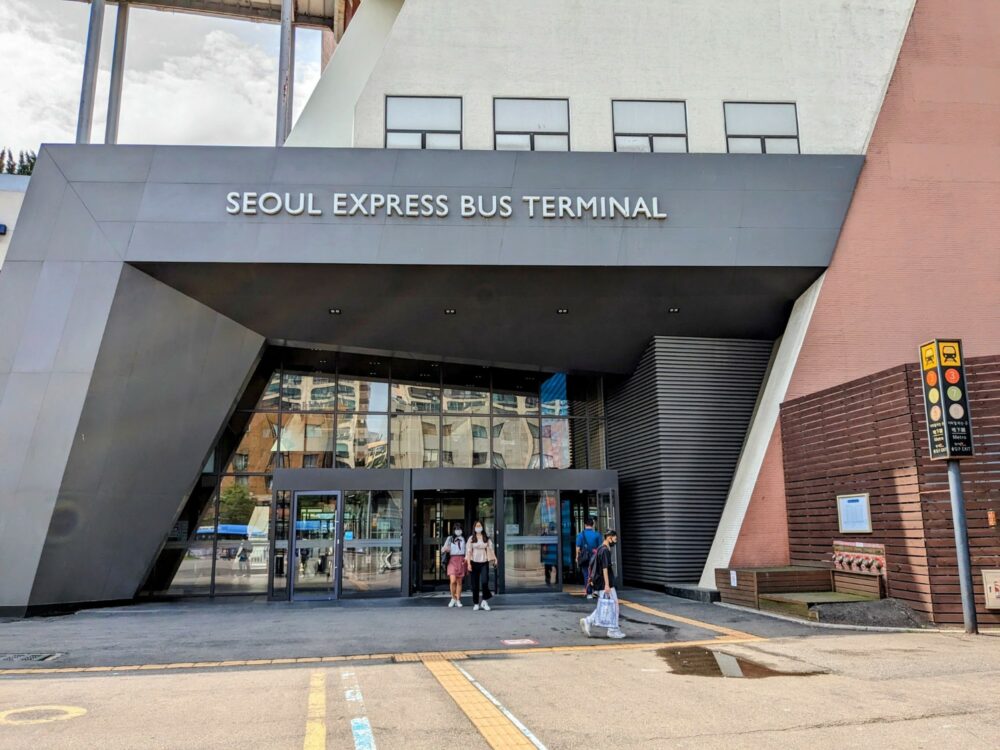
The Express Bus terminal is served by local bus services and is connected directly to line three of the Seoul metro, so it’s easy to get to from most places you’re likely to be staying as a visitor. You can also take a taxi there reasonably easily, which might not be a bad option if you have a lot of luggage.
That’s because, like much of the city’s metro, this line gets very busy at peak times. We were crammed in like sardines, backpacks and all, when we travelled around 9am on a Tuesday morning: fortunately a lot of other people got off at the same station, as making our way to the exit doors would have been near-impossible otherwise!
You can book tickets online in advance: just search for the route from Seoul Express Bus Terminal to Sokcho Express Bus Terminal. It’s a good idea if you want the certainty of traveling at a specific time, but if you’re travelling on a weekday outside the peak September/October autumn foliage viewing period, you can probably just buy them on the day like we did.
Once you get to the bus terminal, head to the ticket desks near the main doors. We started out by trying to use the ticket machines: a friendly, English-speaking staff member was on hand to guide us through the process. It all went well until it came time to pay: not for the first time in South Korea, none of our Visa or Mastercard debit cards worked with the machine.
Fortunately there wasn’t much of a line at the counters nearby, and our cards worked fine there. Buses run roughly every half hour: we couldn’t get on the one that was leaving in ten minutes, but the one after that still had several seats available.
Since we hadn’t had breakfast, we headed down into the shopping area attached to the metro station. Many of the food places weren’t open yet, but we were able to buy a sandwich from Subway, which used up most of the time we had.
The buses leave from a different section of the terminal building to the ticket counters, but the walk only takes a couple of minutes. The platform number is printed on your ticket: just keep going until you see the one you’re after. There are several seats beside the doors to each platform if you need to wait there.
If you’re travelling with luggage larger than a small daypack, you’ll need to stow it under the bus. There’ll likely be someone there beside the luggage hold to take it from you: if not, just put it in yourself. Don’t try to take large bags onboard: they won’t fit in the overhead compartments (or anywhere else).
There’s a ticket scanning machine beside the door: be sure to scan your ticket as you get on, as that’s how the driver knows who made it onboard, and therefore who to wait for at any rest stops along the way.
Bus Types and Prices
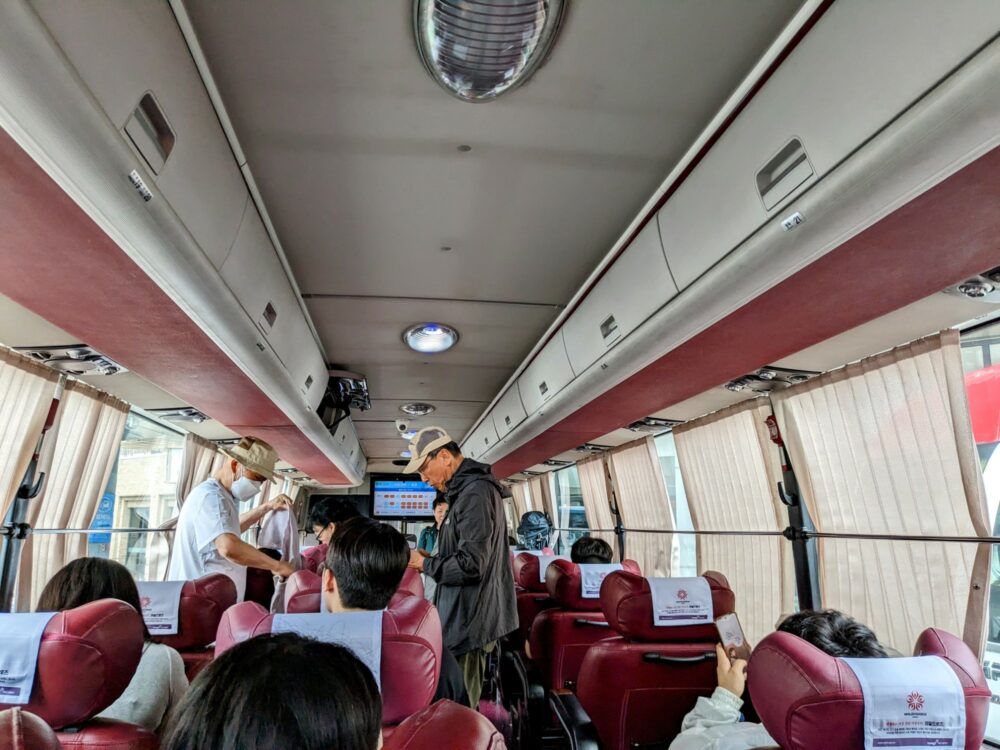
There are three different classes of bus that run from Seoul to Sokcho, and indeed throughout South Korea: premium, excellent, and economy. The premium version has the fewest and fanciest seats, which recline to nearly flat and have USB charging ports available.
Excellent buses don’t have charging sockets and add a few more seats, but still recline to some degree. Economy is the cheapest way of getting from A to B, with basic seats, and more of them. All of the buses take about the same length of time to get between the two cities: roughly 2.5 hours, depending on traffic.
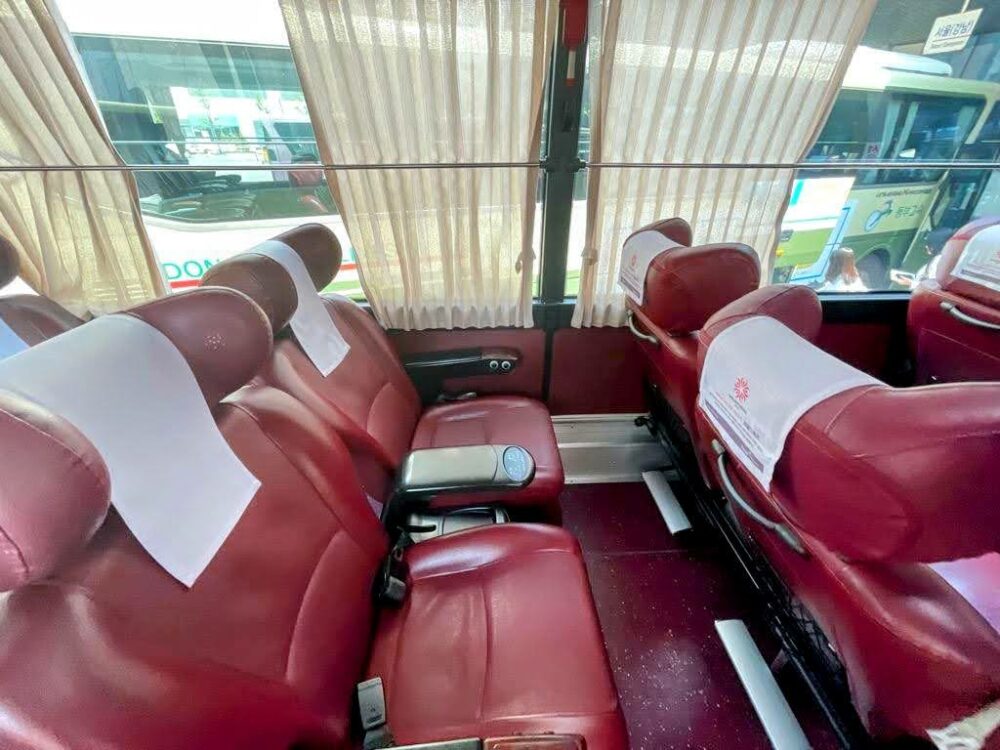
We ended up on an “excellent” bus both there and back, just because it was the next available, and had zero complaints. Both were comfortable and clean, with working air conditioning and safe drivers. In each case they stopped around the halfway mark for about 20 minutes, for a snack/toilet/cigarette break.
Prices are pretty reasonable (they’re the same in both directions):
- Economy: ₩17,200 ($13 USD)
- Excellent: ₩22,300 ($17 USD)
- Premium: ₩28,900 ($22 USD)
Bus From Sokcho to Seoraksan
Buses from Seoul Express terminal arrive at Sokcho Express terminal. Buses from Dong Seoul sometimes go there as well, but usually arrive at Sokcho Intercity terminal instead. The two terminals aren’t all that far from each other, about 5km, but the Express terminal is closer to the national park.
Whichever terminal you arrive at, you’ll then need to switch to a local bus: number 7 or 7-1. From the Express terminal, walk out the main exit: you can see the bus stop you need off to your right, across the multi-lane road in front of you. Cross the road at the nearby traffic lights.
The bus stop has an electronic departures board, so you can see how long you’ll need to wait. They’re scheduled to run roughly every half-hour. It’s possible to pay your fare in cash, but just like in Seoul and elsewhere, it’s much easier to use a T-Money card if you have one.
The journey takes about half an hour from Sokcho Express terminal, and 10-15 minutes longer from the Intercity terminal. Unless you’re staying in one of the hotels near the park, you can just sit back and relax until the bus reaches its final stop at the national park entrance.
If you are getting off before the park entrance, you’ll need to ring the bell to alert the driver. Make sure you’ve got a navigation app open on your phone so you know when to do so: I recommend Naver or Kakao, as Google Maps doesn’t really work in South Korea.
South Korea Travel Tips
If you’re confused about making payments, how taxis and T-Money cards work, why Google Maps is so bad in South Korea, or other logistical stuff, I wrote a guide to that on my other site.
The last bus stop is in the carpark area of the national park. Just walk straight ahead for a couple of minutes: you’ll see the entrance gates and other buildings almost immediately. Buses from Sokcho to the national park start running just before 7am, with the last one returning from the park around 8:30pm.
Returning to Seoul is simply a matter of doing the same thing in reverse. Again, outside peak times you can buy same-day tickets at the bus terminal: we walked in just after 9am on a weekday, and were on the road a little over half an hour later.
There’s a cafe in the station serving coffee (of a sort), but if you’ve got a bit of time to kill, I’d recommend avoiding it in favour of the ten-minute walk down the road to Bossa Nova Coffee Roasters. Trust me, your taste buds will thank you.
Taxi From Sokcho to Seoraksan
While taking the local bus from Sokcho to the national park is pretty straightforward, there are other options. If you’re travelling with a lot of luggage, or are staying at a hotel in Sokcho that isn’t particularly near the bus terminals, it might be easier to take a taxi to the park .
There’s a taxi rank outside Sokcho Express terminal, or you can use the Kakao app to arrange a pickup from your hotel or elsewhere. Likewise, hotel staff should be happy to call you a taxi as needed, or arrange a private driver for you. Note that you may find it harder to get a taxi back again: I only noticed one or two waiting around for a fare when I was there.
Expect to pay somewhere around ₩20,000 ($15 USD) each way for a taxi from Sokcho to Seoraksan. If you arrange a private hire through your hotel, just confirm the price beforehand: there’s no need to pay much more than the going rate for a taxi.
What About the Train?
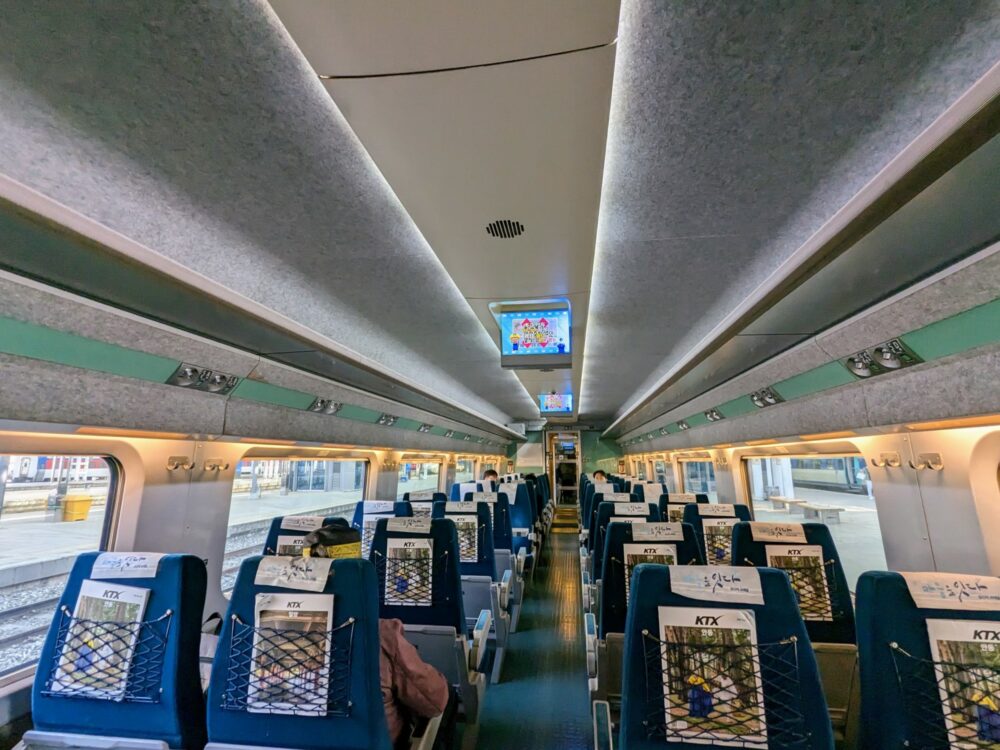
Travelling by train, especially high-speed ones, is an absolute delight in South Korea. Sadly, because Sokchu doesn’t have a railway station, it’s not a delight you’re likely to experience when travelling to Seoraksan.
The nearest place you can catch a train to is Gangneung, some 70km further south along the coast. High-speed KTX services run there from Seoul in a couple of hours, but that’s where the fun stops.
You’d need to catch a local bus from the train station to the intercity bus terminal in Gangneung, an hour-long bus from there to Sokcho, and then the local bus to the national park that I talk about above. It costs more to do it this way, and takes at least an hour longer even if you make every connection perfectly.
In short, unless you want to visit Gangneum anyway, I wouldn’t recommend this option.
Self-Drive
If you have a car in South Korea or are planning to rent one, driving to Seoraksan National Park is a fast and straightforward option. Most of the journey is on the expressway, which means if you don’t get stuck in traffic getting out of Seoul, it only takes about two hours end to end.
Note that the expressway is a toll road: you can pay in cash if you don’t have a HiPass card. If you’re renting your vehicle, check with the rental company about what your payment options are.
You’ll get an estimate of the toll cost if you’re using the Naver app for navigation: expect to pay around ₩11,500 ($9 USD) each way, with discounts available for small vehicles, HiPass users, etc.
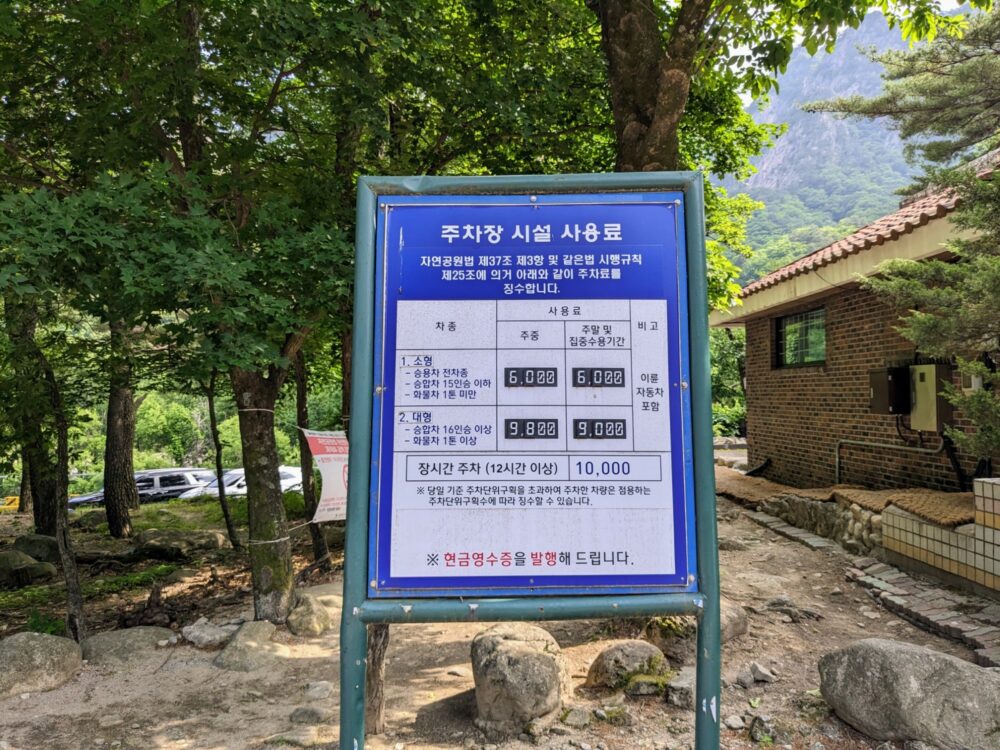
Parking is available at the entrance, divided up into a few different sections. There was plenty of space when we were there on a weekday in May, but it fills up fast at weekends and peak times. Get there early to beat the rush, else you’ll need to park further back down the road and walk or take the bus to the entrance.
Parking costs ₩6000 ($4.50 USD) for most vehicles, for anything up to 12 hours. Stay longer than that, and it’ll cost you ₩10,000 ($7.50 USD) instead.
Organised Tour
If you’re on a tight timeframe, or just don’t want to deal with the logistics involved in getting to and from the national park, the easiest and most convenient option is to head there on an organised tour instead.
That’s especially true if you’re trying to visit Seoraksan as a day trip from Seoul, or if you’d like to see some of the attractions to the east of Seoul that aren’t easily accessible by public transport. Some of the tours go to at least one or two other places, including Alpaca World, Nami Island, and Naksana Temple.
Most day trips have a few different pickup and drop-off points around Seoul, and take somewhere around 13 hours start to finish. If you’re only interested in Seoraksan and want as much time there as possible to hike and look around independently, I’d recommend this inexpensive option, which includes 4-5 hours of free time to explore.
Note that more tours are available during the autumn foliage months (September and October), and others change their itinerary during that time to focus on specific areas. It’s worth checking out all of the options for the dates you’re planning to visit to see what appeals the most.
Because most of these are small group tours, and Seoraksan is very popular during those autumn months, I’d highly recommend booking at least a month or two in advance if that’s the time of year you’ll be travelling.
While most of these trips operate as day tours, that isn’t the only option. At least one company also offers private two-day trips to the park, taking in a couple of guided half-day hikes and staying overnight in Sokcho.
So there you have it, everything you need to know about getting to Seoraksan National Park! If you’ve got any questions that aren’t covered above, feel free to leave them in the comments and I’ll try to help.

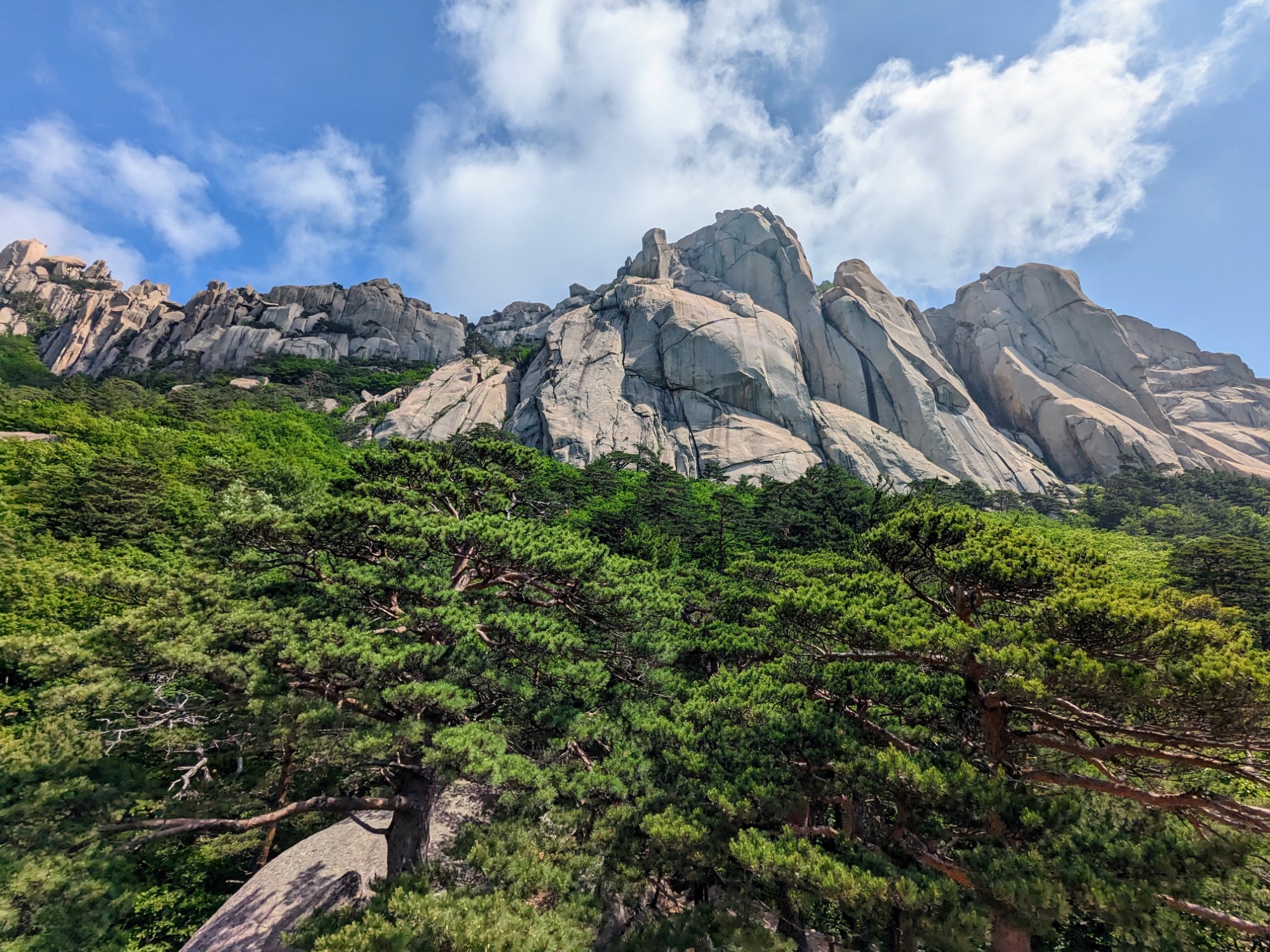
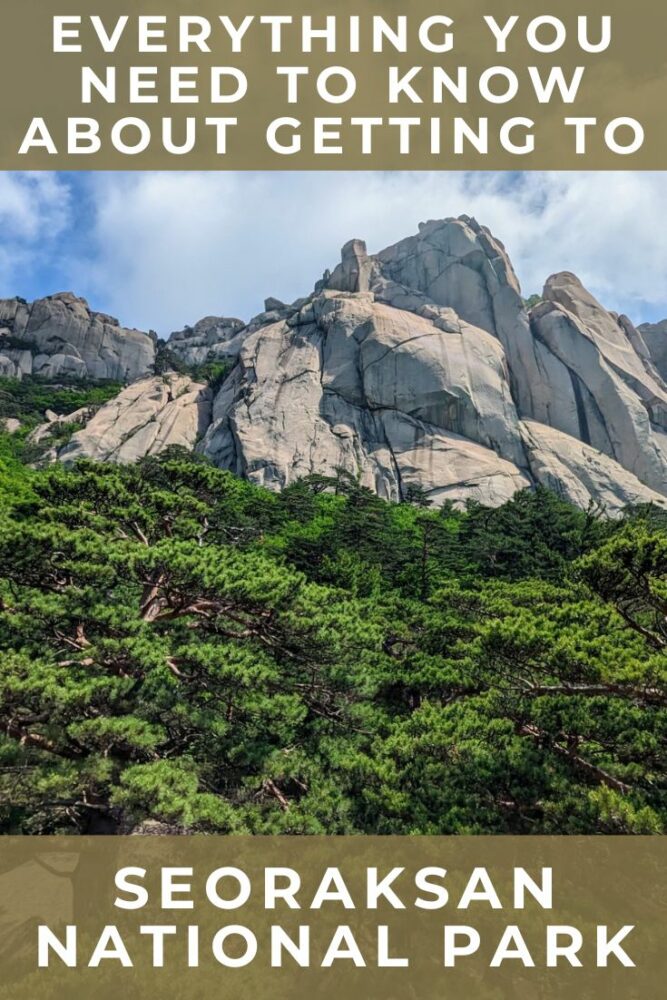
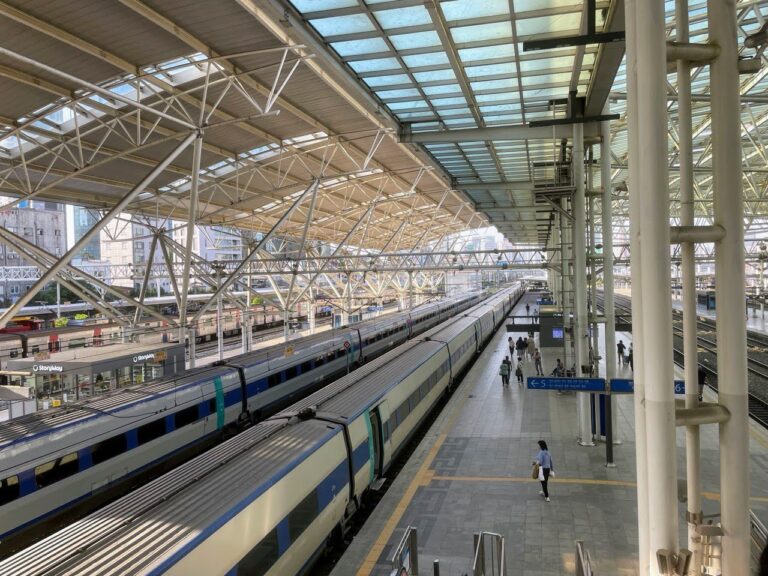
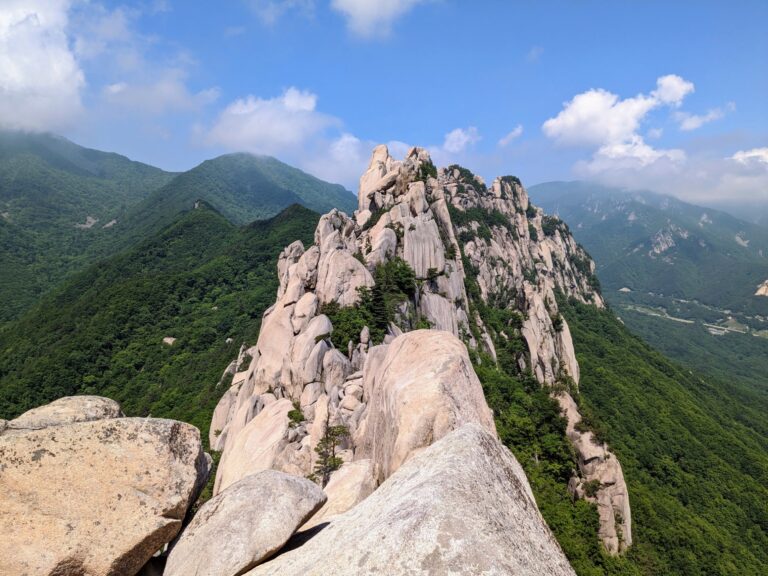
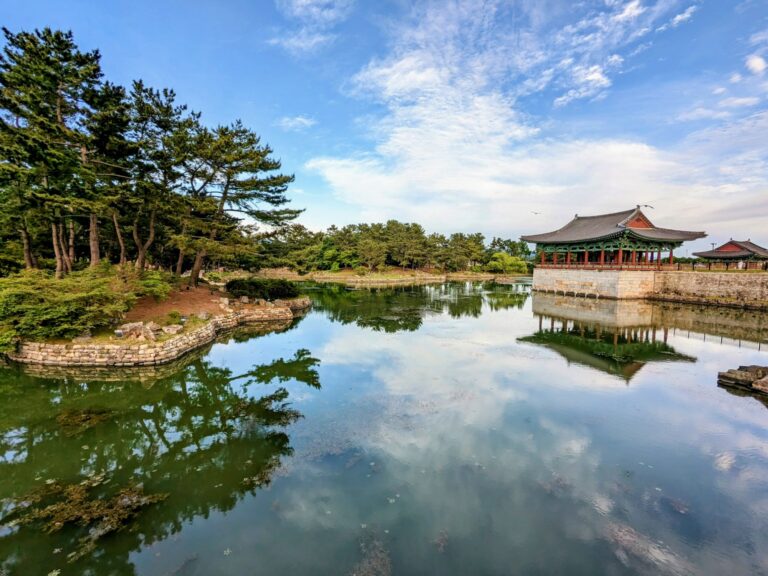
Thanks for figuring this all out Dave! Made it so much easier to make a plan to get there – I’ll be heading off via bus next week 😁
No problem Alice — glad you found it useful! Have a great time at Seoraksan 🙂
This guide was invaluable and helped me make the most of my two days at the park. Thank you for creating it! Through your advice I had a really awesome trip!
Regards Jay.
Thanks so much Jay! I really appreciate it when people find my posts useful and take the time to come back and let me know! 😀